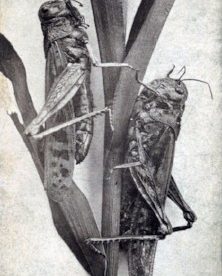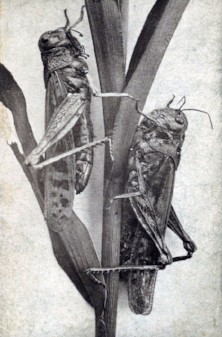The Swarm That Darkened The Skies

Today, if you’re in the United States, the sky will get darker during the day — for an hour or so, at least. The cause, as you surely have heard by now, is a solar eclipse — the moon’s orbit will cross between us and the sun, blocking out the latter’s light.
If you were in Nebraska in 1875, you may have experienced the same effect — darkness during the day. But the cause wasn’t the moon. It was these guys:

Those are locusts, and specifically, a species called the Rocky Mountain locust. These flying grasshoppers measured only about an inch to an inch and a half, which is to say, they’re annoying but hardly a nuisance — at least not on their own. But in the 1870s, and particularly in 1875, they were rarely on their own. It was them and a few billion friends.
The locusts typically laid eggs in the Rocky Mountains (hence the name) and, in good conditions, would remain there, rarely disturbing people. But, per Wikipedia, in certain conditions, they would travel eastward looking for food. That would bring them into the Great Plains, which meant lots to eat — miles and miles of crops upon which to wreak havoc. And they’d eat everything else, too — as the New York Times would later recount, the locusts would even eat “fence posts, laundry hung out to dry and each other,” as well as the blankets people used to cover their gardens when the swarms came.
But the locusts rarely, if ever, consumed the sun. That changed during the spring or summer of 1875 — accounts vary on the actual dates. The largest locust swarm in recorded history descended on the region, paralyzing the farmers and ranchers — and casting a huge shadow, effectively blocking out most of the sunlight for hours at a time. In an article published in American Entomologist (pdf), historian Jeffrey Lockwood described just how big this swarm was:
According to the first-hand account of A. L. Child transcribed by Riley et al. (1880), a swarm of Rocky Mountain locusts passed over Plattsmouth, Nebraska, in 1875. By timing the rate of movement as the insects streamed overhead for 5 days and by telegraphing to surrounding towns, he was able to estimate that the swarm was 1,800 miles long and at least 110 miles wide. Based on his information, this swarm covered a swath equal to the combined areas of Connecticut, Delaware, Maine, Maryland, Massachusetts, New Hampshire, New Jersey, New York, Pennsylvania, Rhode Island, and Vermont.
That’s big — Lockwood would later estimate the number of locusts at 3.5 trillion — and it is as large of a Rocky Mountain locust swarm as the world will ever see again. Less than thirty years after the swarm crossed through middle America, the species of grasshoppers were gone — entirely. The Rocky Mountain locust was last seen in 1902 and is believed to be extinct.
Bonus fact: Now that the Rocky Mountain locust is extinct, North America is the only inhabited continent without locusts.
From the Archives: To Kill a Sparrow: How Mao’s anti-pest became a pest.
Related: “Locust: The Devastating Rise and Mysterious Disappearance of the Insect that Shaped the American Frontier” by the aforementioned Jeffrey Lockwood. 25 reviews averaging 4.2 stars, with one reviewer calling it “as engrossing as The Da Vinci Code but true.”
